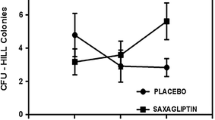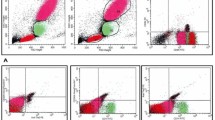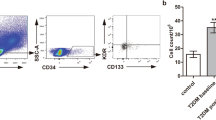Abstract
OBJECTIVE: Endothelial progenitor cells (EPCs) have recently been considered as a potential novel marker of vascular integrity, atherosclerosis and cardiovascular risk. This study was performed to investigate the main determinants of EPC levels in individuals with prediabetes. DESIGN: Thirty-nine participants with newly diagnosed prediabetes were enrolled. Flow cytometric analysis was used to quantify EPCs (CD34 + CD133 + VEGFR-2+). Traditional risk factors, high-sensitivity C-reactive protein (hs-CRP), homeostasis model assessment of insulin resistance (HOMA-IR) and anthropometric parameters, including ultrasonographic-determined visceral and subcutaneous fat, were recorded. RESULTS: In univariate analysis, EPC levels significantly correlated with waist circumference (p = 0.017), mean arterial pressure (p = 0.009), total cholesterol (p = 0.003), hs-CRP (p = 0.006), HOMA-IR (p = 0.031) and visceral fat (p = 0.040). However, in stepwise multivariate ordinal logistic regression analysis, only visceral fat retained its statistical significance (OR=0.79, 95%Cl:0.64–0.98, p = 0.032). CONCLUSIONS: Visceral fat seems to be the main determinant of EPC levels in individuals with prediabetes and to form a plausible link between mild metabolic abnormalities, cardiovascular risk and vascular homeostasis process.
Similar content being viewed by others
References
American Diabetes Association, 2011 Diagnosis and classification of diabetes mellitus. Diabetes Care 34: Suppl 1: 62–69.
Laakso M, 2010 Cardiovascular disease in type 2 diabetes from population to man to mechanisms: the Kelly West Award Lecture 2008. Diabetes Care 33: 442–449.
Davignon J, Ganz P, 2004 Role of endothelial dysfunction in atherosclerosis. Circulation 109: Suppl 1: III27–III32.
Asahara T, Murohara T, Sullivan A, et al, 1997 Isolation of putative progenitor endothelial cells for angiogenesis. Science 275: 964–967.
Urbich C, Dimmeier S, 2004 Endothelial progenitor cells: characterization and role in vascular biology. Circ Res 95: 343–353.
Schmidt-Lucke C, Rössig L, Fichtischerer S, et al, 2005 Reduced number of circulating endothelial progenitor cells predicts future cardiovascular events: proof of concept for the clinical importance of endogenous vascular repair. Circulation 111: 2981–2987.
Werner N, Kosiol S, Schiegl T, et al, 2005 Circulating endothelial progenitor cells and cardiovascular outcomes. N Engl J Med 353: 999–1007.
Fadini G, Agostini C, Sartore S, Avogaro A, 2007 Endothelial progenitor cells in the natural history of atherosclerosis. Atherosclerosis 194: 46–54.
Shantsila E, Watson T, Lip GY, 2007 Endothelial progenitor cells in cardiovascular disorders. J Am Coll Cardiol 49: 741–752.
Fadini GP, Pucci L, Vanacore R, et al, 2007 Glucose tolerance is negatively associated with circulating progenitor cell levels. Diabetologia 50: 2156–2163.
De Lucia Rolfe E, Sleigh A, Finucane FM, et al, 2010 Ultrasound measurements of visceral and subcutaneous abdominal thickness to predict abdominal adiposity among older men and women. Obesity (Silver Spring) 18: 625–631.
Matthews DR, Hosker JP, Rudenski AS, et al, 1985 Homeostasis model assessment: insulin resistance and beta-cell function from fasting plasma glucose and insulin concentrations in man. Diabetologia 28: 412–419.
Thomas HE, Avery PJ, Ahmed JM, et al, 2009 Local vessel injury following percutaneous coronary intervention does not promote early mobilization of endothelial progenitor cells in the absence of myocardial infarction. Heart 95: 555–558.
Sutherland DR, Nayyar R, Acton E, et al, 2009 Comparison of two single-platform ISHAGE-based CD34 enumeration protocols on BD FACSCalibur and FACSCanto flow cytometers. Cytotherapy 11: 595–605.
Fadini GP, Boscaro E, de Kreutzenberg S, et al, 2010 Time course and mechanisms of circulating progenitor cell reduction in the natural history of type 2 diabetes. Diabetes Care 33: 1097–1102.
Dimmeier S, Aicher A, Vasa M, et al, 2001 HMG-CoA reductase inhibitors (statins) increase endothelial progenitor cells via the PI 3-kinase/Akt pathway. J Clin Invest 108: 391–397.
Desouza CV, Hamel FG, Bidasee K, O’Connell K, 2011 Role of inflammation and insulin resistance in endothelial progenitor cell dysfunction. Diabetes 60: 1286–1294.
Seeger FH, Haendeler J, Walter DH, et al, 2005 P38 mitogen-activated protein kinase downregulates endothelial progenitor cells. Circulation 111: 1184–1191.
Verma S, Kuliszewski MA, Li SH, et al, 2004 C-reactive protein attenuates endothelial progenitor cell survival, differentiation, and function: further evidence of a mechanistic link between C-reactive protein and cardiovascular disease. Circulation 109: 2058–2067.
Chang J, Li Y, Huang Y, et al, 2010 Adiponectin prevents diabetic premature senescence of endothelial progenitor cells and promotes endothelial repair by suppressing the p38 MAP kinase/p16INK4A signaling pathway. Diabetes 59: 2949–2959.
Biasucci LM, Graziani F, Rizzello V, et al, 2010 Paradoxical preservation of vascular function in severe obesity. Am J Med 123: 727–734.
Yue WS, Lau KK, Siu CW, et al, 2011 Impact of glycemic control on circulating endothelial progenitor cells and arterial stiffness in patients with type 2 diabetes mellitus. Cardiovasc Diabetol 10: 113.
Stolk RP, Wink O, Zelissen PM, Meijer R, van Gils AP, Grobbee DE, 2001 Validity and reproducibility of ultrasonography for the measurement of intra-abdominal adipose tissue. Int J Obes Relat Metab Disord 25: 1346–1351.
Armellini F, Zamboni M, Robbi R, et al, 1993 Total and intra-abdominal fat measurements by ultrasound and computerized tomography. Int J Obes Relat Metab Disord 17: 209–214.
Author information
Authors and Affiliations
Corresponding author
Rights and permissions
About this article
Cite this article
Angelidi, A., Melidonis, A., Protopsaltis, I. et al. Endothelial progenitor cells as a cardiometabolic risk factor marker in prediabetes. Hormones 13, 244–251 (2014). https://doi.org/10.1007/BF03401338
Received:
Accepted:
Published:
Issue Date:
DOI: https://doi.org/10.1007/BF03401338




